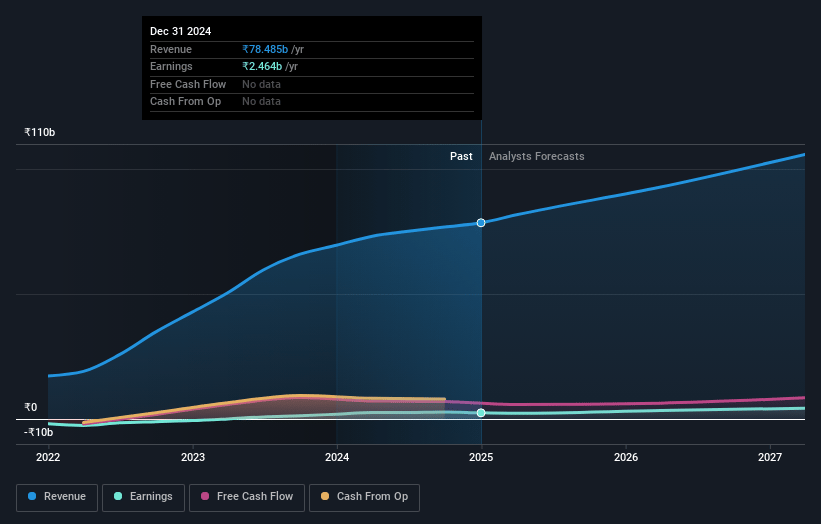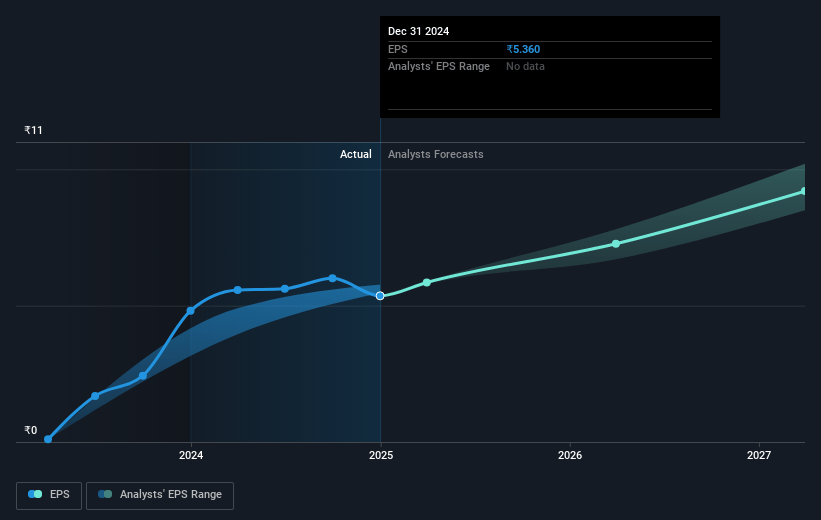Last Update01 May 25Fair value Decreased 6.29%
AnalystConsensusTarget made no meaningful changes to valuation assumptions.
Read more...Key Takeaways
- Consolidating the Nature Trails brand could boost domestic revenue through Thomas Cook's strong distribution network.
- Growth in financial services and leisure expansion through an asset-light model may enhance revenue and improve earnings.
- Leadership changes, geopolitical instability, reliance on large contracts, and seasonal factors may challenge Thomas Cook India's revenue stability and growth.
Catalysts
About Thomas Cook (India)- Offers integrated travel services in India and internationally.
- The consolidation of the Nature Trails brand into Thomas Cook's domestic operations is expected to leverage Thomas Cook's distribution network, potentially increasing domestic revenue growth.
- The company's succession planning, with experienced leadership taking over, is likely to ensure stability and continuous strategic focus, positively impacting earnings.
- The growth in financial services, particularly in foreign exchange driven by digital adoption and prepaid card usage, is expected to enhance revenue and expand net margins.
- The recovery in key international markets like Dubai and significant secured contracts such as the national games in Uttarakhand suggest strong future revenue potential.
- Expansion in the leisure and hospitality sector, with new resort launches and an asset-light model, is expected to boost Sterling's income and improve EBITDA, enhancing overall earnings.
Thomas Cook (India) Future Earnings and Revenue Growth
Assumptions
How have these above catalysts been quantified?- Analysts are assuming Thomas Cook (India)'s revenue will grow by 12.6% annually over the next 3 years.
- Analysts assume that profit margins will increase from 3.1% today to 4.2% in 3 years time.
- Analysts expect earnings to reach ₹4.7 billion (and earnings per share of ₹9.68) by about May 2028, up from ₹2.5 billion today.
- In order for the above numbers to justify the analysts price target, the company would need to trade at a PE ratio of 27.5x on those 2028 earnings, up from 25.4x today. This future PE is lower than the current PE for the IN Hospitality industry at 33.8x.
- Analysts expect the number of shares outstanding to decline by 6.53% per year for the next 3 years.
- To value all of this in today's terms, we will use a discount rate of 15.1%, as per the Simply Wall St company report.
Thomas Cook (India) Future Earnings Per Share Growth
Risks
What could happen that would invalidate this narrative?- The retirement of Madhavan Menon, the Executive Chairman, raises concerns over leadership transition and its potential effect on company performance, which could affect stability and investor confidence, impacting future earnings.
- The geopolitical instability in key markets like Dubai and the U.S., alongside currency volatility affecting international operations, presents risks to sustained revenue growth due to potential disruptions in tourism activities in these regions.
- The company's dependency on large, one-off segments like government contracts for MICE (Meetings, Incentives, Conferences, and Exhibitions) can result in revenue fluctuations and uneven profit margins if these aren't consistently renewed or replaced.
- The ongoing challenges in some DMS units, such as East Africa losing major customers, highlight execution risks in rebuilding and diversifying the customer base, potentially impacting revenue stability.
- The seasonal nature of the travel and hospitality business and external dependencies on factors like high airfares and visa issues might lead to variability in segment performance, posing risks to consistent revenue and profit growth.
Valuation
How have all the factors above been brought together to estimate a fair value?- The analysts have a consensus price target of ₹226.0 for Thomas Cook (India) based on their expectations of its future earnings growth, profit margins and other risk factors.
- In order for you to agree with the analyst's consensus, you'd need to believe that by 2028, revenues will be ₹112.0 billion, earnings will come to ₹4.7 billion, and it would be trading on a PE ratio of 27.5x, assuming you use a discount rate of 15.1%.
- Given the current share price of ₹134.55, the analyst price target of ₹226.0 is 40.5% higher.
- We always encourage you to reach your own conclusions though. So sense check these analyst numbers against your own assumptions and expectations based on your understanding of the business and what you believe is probable.
How well do narratives help inform your perspective?
Disclaimer
AnalystConsensusTarget is a tool utilizing a Large Language Model (LLM) that ingests data on consensus price targets, forecasted revenue and earnings figures, as well as the transcripts of earnings calls to produce qualitative analysis. The narratives produced by AnalystConsensusTarget are general in nature and are based solely on analyst data and publicly-available material published by the respective companies. These scenarios are not indicative of the company's future performance and are exploratory in nature. Simply Wall St has no position in the company(s) mentioned. Simply Wall St may provide the securities issuer or related entities with website advertising services for a fee, on an arm's length basis. These relationships have no impact on the way we conduct our business, the content we host, or how our content is served to users. The price targets and estimates used are consensus data, and do not constitute a recommendation to buy or sell any stock, and they do not take account of your objectives, or your financial situation. Note that AnalystConsensusTarget's analysis may not factor in the latest price-sensitive company announcements or qualitative material.




